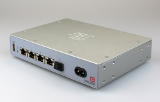
FireBrick - Firewalls, Bonding ADSL, Routers, Traffic Shaping...

Are you IPv6 Ready?
Executive summary
The old version of the Internet (IPv4), which has been around since 1981, is finally full up. Thankfully there is a new version (IPv6) which has been around since 1995, and works along side the old. As a business you should be making sure you are IPv6 Ready, which basically means your computer systems and internet access can handle the new version and the old version of the Internet. It probably means upgrading your Internet router and firewall, but does not mean changing all your computers or wiring or anything too drastic. If your Internet Provider (ISP) is on the ball they will be able to help you, but if not then there are ISPs that can, and who will be more than happy to take over providing your services. What makes this slightly more work for a business user is that you probably have a firewall and it might not be IPv6 Ready. The FireBrick FB2700 is IPv6 Ready and makes switching on IPv6 on your network simple and safe. As the Internet grows using the new version (IPv6) you will gradually find more and more things don't work unless you upgrade and are IPv6 Ready.
There is a web site to check if you are IPv6 Ready, test-ipv6.com. Try it and see.
What do you mean the Internet is full up?
Since the dawn of the Internet we have been using version 4 of the Internet protocol (IPv4). Part of this protocol is the way that computers and other devices connected to the Internet are numbered or addressed. This numbering scheme seemed more than adequate back in 1981, providing over 3.5 billion addresses. Computers were expected to be something universities and banks had, and some larger businesses. Little did the designers know that just three decades later we would have 5 billion mobile phones even.
Back in 1995 the next generation of Internet Protocol was devised, version 6 (IPv6), and this comes with 340 trillion trillion trillion addresses. This time we have enough we are sure. Unfortunately there has been slow progress in getting people to make use of the new version because, well, there was no need!
This is the beginning of the end! Today, we need to use IPv6 because we really have finally run out of the old IPv4 addresses. The last large blocks of addresses allocated by the central authority IANA were given out to the regional registries. During 2011 the regional registries will allocate the last of their addresses to local registries (internet providers) and every ISP will have to start their plans for managing how they will handle actually running out of IPv4 addresses. It won't stop existing computers working on IPv4, but means the Internet cannot grow using IPv4 - it has to use IPv6.
It is not just broadband lines that are an issue - the computers in the internet, the mail servers and web servers and so on - all need IP addresses. As ISPs run out we will start to see web sites that only work on IPv6. If you are not IPv6 Ready you will simply not be able to access them. This is already happening in countries like China.
What should I do?
Well, the good news is that your computers are almost certainly able to handle IPv6 now. Modern operating systems, whether windows, linux, or Mac, already handle IPv6 and it is already enabled. To allow your comupters to make use of IPv6 you just need something on your network to tell them what to do. For a home user this will be a new broadband ADSL router. If you are a business you probably have a firewall which will do the job if it is IPv6 Ready.
You won't need new cabling or switches as these all work at Ethernet level and work fine with IPv6.
So, simply upgrading your firewall / router is probably all you need to do if you just have a simple office network. If you have multiple offices, and if you use firewalling rules to allow access between offices or from home workers, etc, you will need to make sure to take in to account the IPv6 addresses being used. They are longer than good old IPv4 addresses I'm afraid. The FireBrick FB2700 is an ideal firewall for any small/medium business to get you IPv6 Ready quickly and safely.
Ideally you will need an ISP that understands IPv6. If they don't then there are ways to connect you to the IPv6 Internet using tunnels, and the FireBrick can do this for you just as easily. We would recommend using an ISP that knows what they are doing and talking to them for advice on getting your business IPv6 Ready.
For businesses we have already seen advantages in setting up a network properly with IPv4, using real addresses. It avoids a lot of the problems associated with internet sharing systems like NAT. IPv6 does not need NAT as there are enough addresses, so it represents an opportunity for businesses to use the internet properly now, even if stuck behind NAT in the past. Don't see IPv6 as a problem, but as an opportunity.
Web servers
If you have a web site then it is a good idea to ask the provider if they are IPv6 Ready and confirm the site is working using IPv6 now. They may have already enabled IPv6, and some ISPs have done this many years ago. Having IPv6 shows that you are on the ball and ready for the new Internet now.
If your ISP or web site provider are not sure, then it may be worth them looking at some of the FireBrick FB6000 series routers and firewalls for their network. These are ISP grade boxes that support IPv6.
Myths and FAQ
- Is IPv4 using 4 digits and IPv6 using 6? Why can't we just use more digits on IPv4 like 999.999.999.999?
- There have been some really badly worded press articles of late, and they are causing all sorts of confusion. IPv4 is version 4 and IPv6 is version 6 (there was not a 5 as such). The address size of IPv4 is 32 bits and we just write it using decimal - 999.999.999.999 could not fit in 32 bits, so not an answer. IPv6 is 128 bits, and when you see it written down it is much longer and in hexadecimal. We could write IPv4 addresses in hex, but that would not make them more than 32 bits. How we write the address is not important.
- Don't some large companies have huge blocks that they are not using?
- You will hear many ways in which IPv4 addresses have been wasted. This is true to some extent, though not as simple as it sounds. Even if all of the wasted space was re-allocated it would not change the inevitability of IPv4 running out - just delay it perhaps a few months. There are likely to be some blocks given back over time, though this is less likely now we have actually run out as they now have a huge commercial value.
- Will I still be able to acces existing web sites?
- Yes - you run IPv6 along side IPv4. Your computers, phones, etc, work out which version to use automatically for you. In fact, if there is a problem with one they will use the other automatically.
- Will IPv6 be less reliable?
- There is no real reason for IPv6 to be less reliable. There are parts of the internet, and internet providers, that are only just setting up things for IPv6 though. Most are very careful what they do to ensure you have no problems. Over time the old internet is going to get less usable and less reliable as all sorts of tricks are used to share old IPv4 addresses. Over time IPv6 becomes run of the mill for all involved. So any issues you see will be short lived and could affect you anyway whether you have IPv6 or not.

